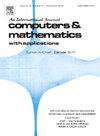应用于Gray-Scott模型的有限元线性化时间步进格式
IF 2.9
2区 数学
Q1 MATHEMATICS, APPLIED
引用次数: 0
摘要
本文描述了一种求解反应扩散系统的数值格式,特别是Gray-Scott模型。该方案是一个两步过程,将第一步的Crank-Nicolson方法与第二步的二阶后向微分公式相结合。这种组合确保了L2和h1规范的无条件稳定性,并允许最佳误差估计。该方法通过时空误差分割技术进一步提高了效率,使得误差估计的推导不受网格大小步长的限制。通过将误差分解为时间分量和空间分量,推导出无条件收敛的结果。通过对时间误差的分析,建立了时间离散系统的规律性。此外,利用经典的Ritz投影实现l2范数的最优空间误差,这对于消除Δt约束至关重要。由于空间误差不依赖于时间步长,因此在L∞范数上数值解的有界性立即遵循一个逆不等式,而不受网格的限制。本文章由计算机程序翻译,如有差异,请以英文原文为准。
A linearized time stepping scheme for finite elements applied to Gray-Scott model
This paper describes a numerical scheme for solving a reaction-diffusion system, specifically the Gray-Scott model. The scheme is a two-step process, combining the Crank-Nicolson method in the first step with the second-order backward differentiation formula in the second step. This combination ensures unconditional stability in both and -norms and allows for optimal error estimates. The scheme's efficiency is further enhanced by a temporal-spatial error splitting technique, enabling the derivation of error estimates without any restrictions on meshes size steps. By dividing the error into temporal and spatial components, the unconditional convergence result is deduced. The regularity of a time-discrete system is established through the analysis of the temporal error. Additionally, the classical Ritz projection is used to achieve the optimal spatial error in the -norm, which is crucial for eliminating the constraint of Δt. Since the spatial error is not dependent on the time step, the boundedness of the numerical solution in -norm follows an inverse inequality immediately without any restriction on the grid mesh.
求助全文
通过发布文献求助,成功后即可免费获取论文全文。
去求助
来源期刊

Computers & Mathematics with Applications
工程技术-计算机:跨学科应用
CiteScore
5.10
自引率
10.30%
发文量
396
审稿时长
9.9 weeks
期刊介绍:
Computers & Mathematics with Applications provides a medium of exchange for those engaged in fields contributing to building successful simulations for science and engineering using Partial Differential Equations (PDEs).
 求助内容:
求助内容: 应助结果提醒方式:
应助结果提醒方式:


